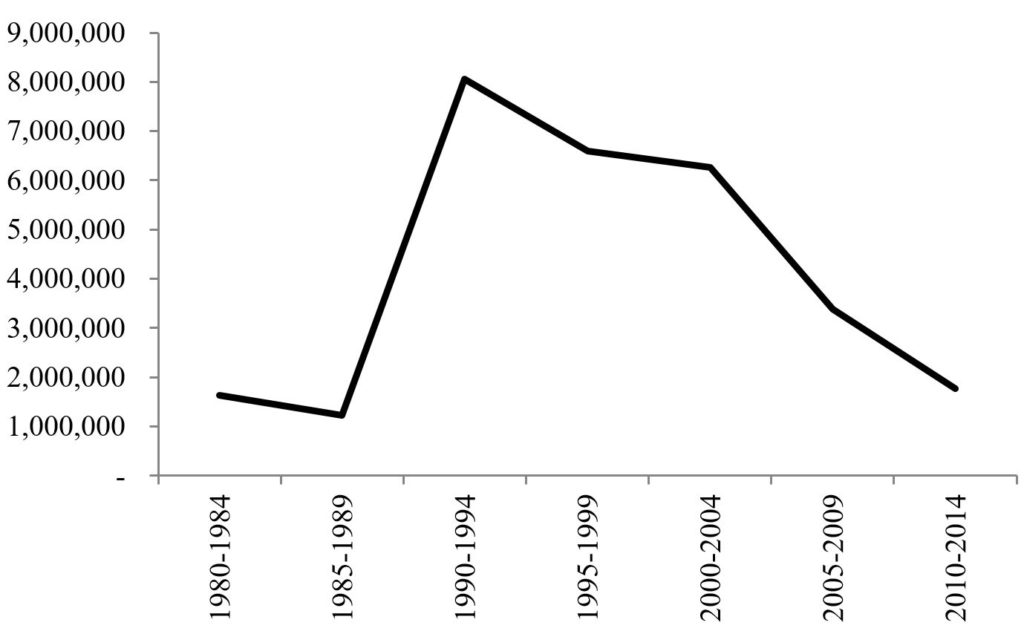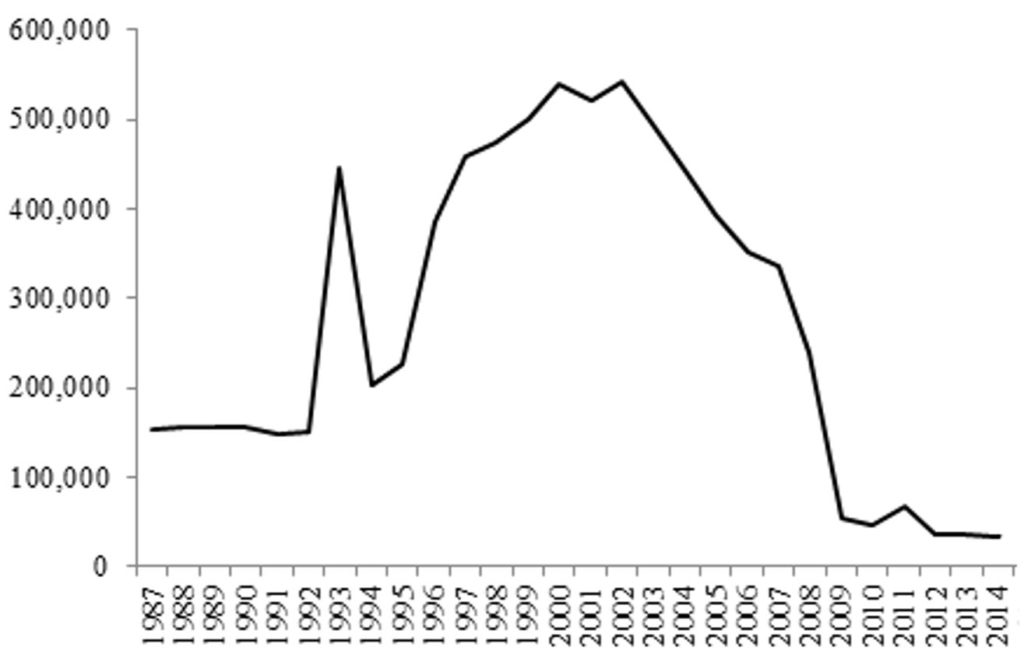In refugee policy circles the return of displaced communities to their home countries (i.e. repatriation) is generally seen as the most pragmatic solution and the end goal to the challenges of international displacement. Aside from the many difficulties that individuals face in their return journeys, repatriation may also bring challenges for the receiving country. Some have even argued that repatriation could be a threat to economic and political stability in receiving communities, which are just recovering from conflict. However, there is scarce evidence on the economic and social consequences of refugee repatriation for the communities of return. Isabel Ruiz and I shed light on this in a new paper in the Journal of Economic Geography.
Understanding the implications of repatriation is important, particularly if the numbers of refugees returning home increases substantially and suddenly. As shown in Figure 1, the worldwide number of refugees returning home, increased from 1.2 million during 1984-1989 to over 8 million in 1990-1994. Countries such as Afghanistan, Iraq, Mozambique, Rwanda, and Sudan experienced the return of over 350,000 former refugees in a single year. The number of returnees decreased substantially during the 2000s, because of the increase in the number of protracted emergencies. However, the repatriation of refugees has once again become a key priority in the international policy agenda and plays a key role in the recent Global Compact on Refugees.
Figure 1. Number of refugees returning home worldwide

Source of data: United Nations High Commissioner for Refugees.
The Impacts of Return
Just a handful of recent papers have focused on the broader impacts of repatriation for receiving communities and the receiving country. Bahar, Hauptmann, Özgüzel and Rapoport explored the impact of refugee return from Germany to the former Yugoslavia on export performance. Their results suggest positive impacts of refugee return for export performance, a result that is driven by the fact that refugees were exposed to work in particular industries in Germany and brought back knowledge, which translated, into higher productivity in those same industries. This is consistent with the literature for different countries on the impact of returning economic migrants who typically bring new knowledge and capital with them, are more likely to be entrepreneurs than those who never migrated and have a substantial positive economic impact on the country of return.
Contrary to the case of Germany during the Yugoslavian conflict and to cases of economic migration, in many situations of forced displacement, particularly in neighbouring developing countries, refugees face strong limitations on the types of economic activities that they can engage in and on their mobility. In these cases, refugees are unlikely to accumulate much physical capital, gain business experience or increase their knowledge of production techniques. The benefits of return migration for those receiving communities and countries may not materialise to the same extent.
In our study, we use data from Burundi, a country that experienced large-scale conflict-led emigration and substantial post-war repatriation, to explore the consequences of refugee repatriation in a context in which refugees faced strong restrictions on economic activities and mobility while abroad. The empirical analysis relies on data from a longitudinal survey conducted in 2011 and 2015. Burundi experienced a conflict from 1993 to 2005, which led to approximately 10% of its population to be internationally displaced. Tanzania, the main host country of Burundian refugees at the time, put pressure on refugees to return home and eventually closed the refugee camps, repatriating the remaining refugees from the 1993 conflict. Between 2000 and 2010 hundreds of thousands of refugees returned to Burundi.
Figure 2. Number of Burundian refugees in Tanzania

Source of data: United Nations High Commissioner for Refugees.
Our results suggest that a greater share of returnees in a community led to less livestock ownership for stayee households. Additional exploration suggests that repatriation had a negative impact on land access, food security and subjective well-being for stayees. The impacts on subjective well-being and food insecurity disappear across rounds of the survey. In particular, we show that the presence of returnees led to changes in economic activities of stayees across rounds of the survey and a decrease in reliance on land harvesting for household food consumption in the second round of the survey.
These findings suggest that, in certain cases, promoting (or forcing) large-scale repatriation may not provide a sustainable solution to the “problem”, but may simply relocate it and perpetuate cycles of conflict. It also highlights the potential importance of getting the displaced population engaged in economic activities while in the host country.
Paper
Isabel Ruiz and Carlos Vargas-Silva (2020) “The Impacts of Refugee Repatriation on Receiving Communities.” Journal of Economic Geography; https://doi.org/10.1093/jeg/lbaa004
A note on Funding:
The results discussed in this blog are part of the research project The Labour Market Impacts of Forced Migration (LAMFOR), a three-year study conducted at the Centre on Migration, Policy and Society (COMPAS) at the University of Oxford. LAMFOR was supported by the UK Department of International Development (DFID) and the Institute for the Study of Labour (IZA) Growth and Labour Markets in Low Income Countries Programme (GLM | LIC). The views expressed in this document are not necessarily those of DFID, IZA or GLM | LIC.
